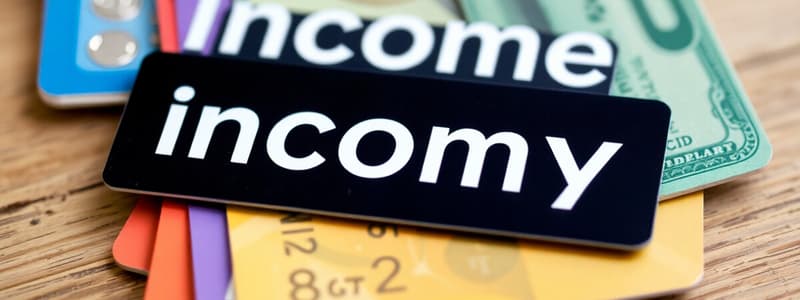Podcast
Questions and Answers
What is the key difference between gross income and net income?
What is the key difference between gross income and net income?
- Gross income includes capital gains, while net income does not.
- Net income only counts the income from investments, while gross income doesn't.
- Gross income is calculated after taxes and deductions, whereas net income is before.
- Gross income always exceeds net income due to taxes and deductions. (correct)
What type of financial product uses borrowed money that must be repaid, often with potential interest charges?
What type of financial product uses borrowed money that must be repaid, often with potential interest charges?
- Capital account
- Right-of-occupancy payment
- Credit card (correct)
- Debit card
Which of the following is a potential disadvantage of using a credit card?
Which of the following is a potential disadvantage of using a credit card?
- Enhanced fraud protection on purchases.
- Earning rewards like cashback.
- The risk of accumulating debt if not managed properly. (correct)
- An initial interest-free period.
According to the provided material, what is a unique feature of credit cards in Finland compared to some other countries?
According to the provided material, what is a unique feature of credit cards in Finland compared to some other countries?
What is the primary characteristic of a right-of-occupancy home?
What is the primary characteristic of a right-of-occupancy home?
Which of the following does not directly impact a home's price?
Which of the following does not directly impact a home's price?
What is the purpose of a security deposit for a rental home?
What is the purpose of a security deposit for a rental home?
What is an advantage of owning a home, as stated?
What is an advantage of owning a home, as stated?
Which of the following is a key goal of the circular economy?
Which of the following is a key goal of the circular economy?
In the context of entrepreneurship, what is a primary way an entrepreneur can use the profit generated by their business?
In the context of entrepreneurship, what is a primary way an entrepreneur can use the profit generated by their business?
Which of the following is a characteristic of a limited company (Osakeyhtiö) in Finland?
Which of the following is a characteristic of a limited company (Osakeyhtiö) in Finland?
What is 'elinkeino vapaus' in the context of Finnish entrepreneurship?
What is 'elinkeino vapaus' in the context of Finnish entrepreneurship?
What does a surplus in Finland's current account indicate?
What does a surplus in Finland's current account indicate?
Which of these is a potential negative effect of globalization?
Which of these is a potential negative effect of globalization?
What is the key difference between a private trader (Toiminimi) and a general partnership (Avoin yhtiö)?
What is the key difference between a private trader (Toiminimi) and a general partnership (Avoin yhtiö)?
In the context of business planning, what is the purpose of a 'business plan'?
In the context of business planning, what is the purpose of a 'business plan'?
What defines productivity in a business context?
What defines productivity in a business context?
What is the role of silent partners in a limited partnership (Kommandiittiyhtiö)?
What is the role of silent partners in a limited partnership (Kommandiittiyhtiö)?
Which of the following best describes the primary function of the European Central Bank (ECB)?
Which of the following best describes the primary function of the European Central Bank (ECB)?
What is the key characteristic that distinguishes a 'Määräaikainen' employment contract from a 'Toistaiseksi Voimassa Oleva' contract in Finland?
What is the key characteristic that distinguishes a 'Määräaikainen' employment contract from a 'Toistaiseksi Voimassa Oleva' contract in Finland?
A country is experiencing high inflation due to increased consumer spending and readily available credit. According to economic principles, what type of inflation is this and what action might the central bank take?
A country is experiencing high inflation due to increased consumer spending and readily available credit. According to economic principles, what type of inflation is this and what action might the central bank take?
An individual notices that prices for most goods and services have increased by an average of 5% compared to last year. Which economic term best describes this situation?
An individual notices that prices for most goods and services have increased by an average of 5% compared to last year. Which economic term best describes this situation?
Which of the following best describes the concept of Purchasing Power Parity (PPP)?
Which of the following best describes the concept of Purchasing Power Parity (PPP)?
In Finland, what is the primary source of revenue for the national budget?
In Finland, what is the primary source of revenue for the national budget?
During which phase of the economic cycle are you most likely to see low unemployment rates coupled with increased access to loans?
During which phase of the economic cycle are you most likely to see low unemployment rates coupled with increased access to loans?
What does the Human Development Index (HDI) measure?
What does the Human Development Index (HDI) measure?
What is a 'Rivitalo' in the context of Finnish housing?
What is a 'Rivitalo' in the context of Finnish housing?
Which of the following is an example of an indirect tax in Finland?
Which of the following is an example of an indirect tax in Finland?
A country’s GDP adjusted to include environmental and social costs for economic activity is called?
A country’s GDP adjusted to include environmental and social costs for economic activity is called?
Which of the following is a key indicator of the peak phase in the economic cycle?
Which of the following is a key indicator of the peak phase in the economic cycle?
Which of these factors typically has a negative influence on loan approval?
Which of these factors typically has a negative influence on loan approval?
What role does a Certificate of Work (Työtodistus) play within the Finnish employment system?
What role does a Certificate of Work (Työtodistus) play within the Finnish employment system?
What economic policy tool can the government use to stimulate the economy during a recession?
What economic policy tool can the government use to stimulate the economy during a recession?
Flashcards
Capital Income
Capital Income
Money gained from possession of wealth (e.g., rental income, investments, sales)
Net Income
Net Income
Income after taxes and deductions are taken out
Gross Income
Gross Income
Income before taxes and deductions are taken out
Debit Card
Debit Card
Signup and view all the flashcards
Credit Card
Credit Card
Signup and view all the flashcards
Right-of-Occupancy Home
Right-of-Occupancy Home
Signup and view all the flashcards
Security Deposit
Security Deposit
Signup and view all the flashcards
Location
Location
Signup and view all the flashcards
Circular Economy
Circular Economy
Signup and view all the flashcards
Productivity
Productivity
Signup and view all the flashcards
Elinkeinovapaus (Freedom to Conduct Business)
Elinkeinovapaus (Freedom to Conduct Business)
Signup and view all the flashcards
Business Plan
Business Plan
Signup and view all the flashcards
Limited Company (Osakeyhtiö, Oy/Oyj)
Limited Company (Osakeyhtiö, Oy/Oyj)
Signup and view all the flashcards
Private Trader (Toiminimi, Tmi)
Private Trader (Toiminimi, Tmi)
Signup and view all the flashcards
General Partnership (Avoin yhtiö, Ay)
General Partnership (Avoin yhtiö, Ay)
Signup and view all the flashcards
Limited Partnership (Kommandiittiyhtiö, Ky)
Limited Partnership (Kommandiittiyhtiö, Ky)
Signup and view all the flashcards
Cooperative (Osuuskunta, Osk)
Cooperative (Osuuskunta, Osk)
Signup and view all the flashcards
Goal of a Business
Goal of a Business
Signup and view all the flashcards
Gross Domestic Product (GDP)
Gross Domestic Product (GDP)
Signup and view all the flashcards
Human Development Index (HDI)
Human Development Index (HDI)
Signup and view all the flashcards
Genuine Progress Indicator (GPI)
Genuine Progress Indicator (GPI)
Signup and view all the flashcards
Purchasing Power Parity (PPP)
Purchasing Power Parity (PPP)
Signup and view all the flashcards
Expansion (Economic Phase)
Expansion (Economic Phase)
Signup and view all the flashcards
Peak (Economic Phase)
Peak (Economic Phase)
Signup and view all the flashcards
Recession (Economic Phase)
Recession (Economic Phase)
Signup and view all the flashcards
Depression (Economic Phase)
Depression (Economic Phase)
Signup and view all the flashcards
Inflation
Inflation
Signup and view all the flashcards
Demand-Pull Inflation
Demand-Pull Inflation
Signup and view all the flashcards
Cost-Push Inflation
Cost-Push Inflation
Signup and view all the flashcards
Fiscal Policy (Recession Recovery)
Fiscal Policy (Recession Recovery)
Signup and view all the flashcards
Monetary Policy (Recession Recovery)
Monetary Policy (Recession Recovery)
Signup and view all the flashcards
Study Notes
Gross and Net Income
- Gross Income: Income before taxes and deductions.
- Net Income: Income after taxes and deductions.
- Capital Income: Money gained from assets like rentals or investments.
Credit Cards in Finland
- Debit Card: Uses direct funds from your bank account.
- Credit Card: Uses borrowed money (credit) that must be repaid with interest if not paid in full.
Credit Card Pros and Cons
- Pros:
- Security in transactions, fraud protection.
- Bonuses and perks (points, cashback).
- Interest-free period.
- Cons:
- Fees (annual, late payment).
- Risk of overspending.
- Potential for debt issues if not managed properly.
Credit Card Facts in Finland
- Minimum age for a credit card: 18.
- No credit history or credit score needed; everyone begins with a clean record.
Darius's Life Hack
- Don't get a credit card unless you need one.
Home Prices and Types
- Factors Affecting Home Prices:
- Location (neighborhood, proximity to services, schools).
- Home condition (repairs, renovations).
- Size (square footage, number of rooms).
- Age (maintenance needs of older homes).
- Housing market trends (supply, demand, economy).
- Extras (pools, garages, high-end appliances).
Rental Homes
- Pros:
- Flexibility, easier to obtain.
- No responsibility for renovations or maintenance.
- Cons:
- Rent money goes to the landlord, not towards ownership.
- Landlord approval for changes.
- Risk of relocation.
Security Deposit (Rental)
- Typically 1-3 times the monthly rent.
- Refunded if rent is paid, property is clean, and no damage is done.
Right-of-Occupancy Homes
- A blend of renting and owning.
- Costs: Initial payment of 15% of home price, plus monthly residence charge (like rent).
Home Ownership
- Pros:
- Complete control over home improvements.
- Potential investment gains (property value increase).
- Builds personal equity.
- Cons:
- Less flexibility to move.
- Responsibility for renovations and maintenance.
- Rising interest rates increase mortgage costs.
Factors Influencing Loan Approval
- Income (ability to repay).
- Employment type (permanent/full-time preferred).
- Expenses (monthly costs, liabilities).
- Family size (fewer dependents).
- Down payment (larger down payments often mean better terms).
Types of Finnish Homes
- Omakotitalo: Single-family home.
- Paritalo: Duplex/semi-detached.
- Rivitalo: Rowhouse.
- Kerrostalo: Apartment building.
- Luhtitalo: Apartment with outdoor corridors.
- Erillistalo: Detached house, often part of a complex.
Employment Contracts in Finland
- Can be verbal, electronic, or written.
- Types:
- Fixed-term (määräaikainen): For specific projects, seasons, or substitutions.
- Indefinite (toistaiseksi voimassa oleva): Permanent employment.
Wages and Collective Bargaining
- No national minimum wage.
- Pay is set by collective bargaining agreements (työehtosopimus) for the industry.
- If no CBA, pay is negotiated individually.
Certificate of Work (Työtodistus)
- Records employment history and job duties.
- May include performance evaluation if requested.
Tax Card (Verokortti)
- Needed for tax deductions.
- Based on estimated yearly income.
- Can be updated anytime your income changes.
Working Hours for Students
- Maximum 2 hours during school days.
- Maximum 7 hours on days off.
- Combined limit of 8 hours per day (school and work).
- Weekly limit of 12 hours.
Economic Indicators
- GDP (Gross Domestic Product): Market value of all final goods and services produced in a country.
- HDI (Human Development Index): Measures human development using health, education, and income.
- GPI (Genuine Progress Indicator): Adjusts GDP to account for environmental and social costs.
- PPP (Purchasing Power Parity): Compares relative purchasing power of currencies.
Economic Phases
- Expansion: Increased consumption, GDP growth, high employment.
- Peak: Rapidly increasing wages and prices; overheated economy.
- Recession: Declining production, layoffs, reduced consumption.
- Depression: Severe, prolonged recession with widespread financial challenges.
Inflation
- Inflation is the rate of price increases.
- Demand-Pull Inflation: Occurs when demand for goods exceeds supply.
- Cost-Push Inflation: High production costs increase prices.
Managing Inflation
- When inflation is high, the ECB raises interest rates to slow spending.
- When the economy struggles, the ECB lowers interest rates to encourage spending and growth.
European Central Bank (ECB)
- Manages monetary policy for the Eurozone.
- Uses interest rates to manage economic growth and inflation.
Recession Recovery Strategies
- Fiscal Policy: Government spending on infrastructure or direct aid. Tax cuts to stimulate spending.
- Monetary Policy: Lower interest rates to reduce borrowing costs and encourage spending.
National Budget and Taxation
- The national budget funds public services.
- Revenue comes mainly from taxes.
- Deficit: Government spending exceeds revenue, increasing national debt.
- Surplus: Government revenue exceeds spending, lessening debt.
- Direct Taxes: Taken directly from income (e.g., income tax, municipal tax).
- Indirect Taxes: Added to goods/services (e.g., VAT, excise taxes).
Globalization
- Globalization is the process of worldwide interaction and integration.
- Pros: Access to goods, lower prices, market expansion, reduced conflict.
- Cons: Global economic downturns, increased competition, monopolies, wealth gaps, and environmental damage.
Measuring Trade
- Current Account: Measures the economic balance of Finland (revenue vs. spending).
Circular Economy
- A sustainable economic model focused on services (sharing, renting, recycling).
- Key goals include minimizing waste and maximizing resource efficiency.
Entrepreneurship and Business Structures
- Goal of a business is profit, either kept for personal use or reinvested for growth.
- Factors of Production: Capital, raw materials, workers.
- Productivity: Output ratio to input.
- Business Idea defines what the company will offer and for whom.
- Forms of Business:
- Private Trader (Toiminimi, Tmi): One person, full control, personal liability.
- General Partnership (Avoin yhtiö, Ay): Two or more, similar to Tmi but with multiple owners.
- Limited Partnership (Kommandiittiyhtiö, Ky): Liable and silent partners (investors).
- Limited Company (Osakeyhtiö, Oy/Oyj): Share ownership, limited liability.
- Cooperative (Osuuskunta, Osk): Member-owned, focused on services/products for members.
Studying That Suits You
Use AI to generate personalized quizzes and flashcards to suit your learning preferences.




